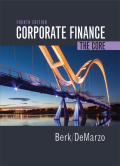
a)
To determine: The unlevered value for Company T.
Introduction:
The unlevered cost of capital is an assessment using either an actual debt-free or hypothetical to measure a firm’s cost to implement a particular capital project. The unlevered cost of capital must demonstrate whether the project is less expensive than a levered cost of capital.
b)
To determine: The levered value for Company T.
Introduction:
The leverage can also refer to the amount of debt used to finance assets. Leverage uses borrowed funds or various financial instruments to increase the
c)
To determine: The amount of debt that is necessary for initial expansion.
Introduction:
Debt is a money borrowed by one party from another that is used by many companies and individuals to make large purchase.
d)
To determine: The debt-to-value ratio and WACC.
Introduction:
WACC (Weighted Average Cost of Capital) is the rate that a company is expected to pay to all the security holders, on an average, in order to finance its assets.
Debt is a money borrowed by one party from another that is used by many companies and individuals to make large purchase.
e)
To determine: The levered value of the expansion using the WACC method.
Introduction:
The leverage can also refer to the amount of debt used to finance assets. Leverage uses borrowed funds or various financial instruments to increase the returns on the investment. If a company has high leverage, it means that it has more debt than equity.
WACC (Weighted Average Cost of Capital) is the rate that a company is expected to pay to all the security holders, on an average, in order to finance its assets.
Want to see the full answer?
Check out a sample textbook solution
Chapter 18 Solutions
EBK CORPORATE FINANCE
- Crenshaw, Incorporated, is considering the purchase of a $367,000 computer with an economic life of five years. The computer will be fully depreciated over five years using the straight-line method. The market value of the computer will be $67,000 in five years. The computer will replace five office employees whose combined annual salaries are $112,000. The machine will also immediately lower the firm's required net working capital by $87,000. This amount of net working capital will need to be replaced once the machine is sold. The corporate tax rate is 22 percent. The appropriate discount rate is 15 percent. Calculate the NPV of this project. Note: Do not round intermediate calculations and round your answer to 2 decimal places, e.g., 32.16. NPV Answer is complete but not entirely correct. S 103,141.80arrow_forwardYour firm is contemplating the purchase of a new $610,000 computer-based order entry system. The system will be depreciated straight-line to zero over its five-year life. It will be worth $66,000 at the end of that time. You will save $240,000 before taxes per year in order processing costs, and you will be able to reduce working capital by $81,000 (this is a one-time reduction). If the tax rate is 21 percent, what is the IRR for this project? Note: Do not round intermediate calculations and enter your answer as a percent rounded to 2 decimal places, e.g., 32.16. IRR %arrow_forwardQUESTION 1 Examine the information provided below and answer the following question. (10 MARKS) The hockey stick model of start-up financing, illustrated by the diagram below, has received a lot of attention in the entrepreneurial finance literature (Cumming & Johan, 2013; Kaplan & Strömberg, 2014; Gompers & Lerner, 2020). The model is often used to describe the typical funding and growth trajectory of many startups. The model emphasizes three main stages, each of which reflects a different phase of growth, risk, and funding expectations. Entrepreneur, 3 F's Debt(banks & microfinance) Research Business angels/Angel Venture funds/Venture capitalists Merger, Acquisition Grants investors PO Public market Growth (revenue) Break even point Pide 1st round Expansion 2nd round 3rd round Research commercial idea Pre-seed Initial concept Seed Early Expansion Financial stage Late IPO Inception and prototype Figure 1. The hockey stick model of start-up financing (Lasrado & Lugmayr, 2013) REQUIRED:…arrow_forward
- critically discuss the hockey stick model of a start-up financing. In your response, explain the model and discibe its three main stages, highlighting the key characteristics of each stage in terms of growth, risk, and funding expectations.arrow_forwardSolve this problem please .arrow_forwardSolve this finance question.arrow_forward

 Intermediate Financial Management (MindTap Course...FinanceISBN:9781337395083Author:Eugene F. Brigham, Phillip R. DavesPublisher:Cengage Learning
Intermediate Financial Management (MindTap Course...FinanceISBN:9781337395083Author:Eugene F. Brigham, Phillip R. DavesPublisher:Cengage Learning EBK CONTEMPORARY FINANCIAL MANAGEMENTFinanceISBN:9781337514835Author:MOYERPublisher:CENGAGE LEARNING - CONSIGNMENT
EBK CONTEMPORARY FINANCIAL MANAGEMENTFinanceISBN:9781337514835Author:MOYERPublisher:CENGAGE LEARNING - CONSIGNMENT


